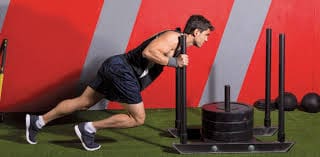Strength or Explosive Power: What you need!

By: Josh Bryant
Explosive power is king on thefield of play—it’s even crucial if your training objectives are no moreambitious than building the speed necessary to clear your office cubicle tobeat the crowds to your favorite happy hour.
I will continue to beat the dead horse that limit strengthis your base.
Someathletes need more explosive power; others just flat out need to increase theirlimit strength!
Let’stake a look at a method to help evaluate an athlete’s strength/power needs.
The vertical jump has been around since dinosaurs roamedthe Earth as an established method of evaluating an athlete’s powercapabilities and can help prognosticate sporting success. I was firstintroduced to the Eccentric Utilization in 2010 by renowned sports scientist,Dr. Michael Hartman.
By evaluating the athlete’s eccentric utilization ratio(EUR) in the vertical jump, we can learn if the athlete is deficient in limit strengthor explosive power and, more importantly, needs to take place in training.
Evaluating the vertical jump commonly uses two techniques:the counter movement vertical jump (CMJ) and the squat jump.
The CMJ is what you see athletes testing at NFL combinesand most athletic evaluations. The CMJbegins with the athletes standing straight up; athletes then dip their butt toa self-selected depth. Upon reaching the optimal depth, the athlete immediatelyjumps up. The stretch shortening cycle is taken advantage of during the dipdown/eccentric phase of the jump by effectively storing elastic energy thatwill aid the athlete in jumping higher. In other words, you pull back like arubber band, release and jump higher. Elastic energy is assisting you on the way up—the better you do this—themore effective you are on the field of play.
The Squat Jump (SJ) as a vertical jump assessment is muchless commonly used. When performing the SJ, the athlete will bend his knees to90° and hold that position for a minimum of three seconds. After holding at thebottom, the athlete jumps as high as possible. Because the downward phase ofthe jump has been eliminated, elastic energy that would assist the actual jumphas been eliminated.
A majority of athletes will be able to jump 2 to 4 incheshigher using the CMJ technique. If you are worried about an athlete notproperly utilizing arm swing on the CMJ (and how that may skew the results), havethe athlete perform both jumps with a broom stick or PVC pipe on his back.Obviously, an electronic vertical jump mat will be needed.
Without busting out the lab coat or the test tubes, theeccentric EUR is, simply, the CMJ divided by the squat jump. The higher theratio, the better the athlete is at using elastic energy from thestretch-shortening cycle.
What’s does this mean, training wise?
If an athlete has a low EUR, he will benefit more fromplyometrics, explosive lifts and explosive training in general to eradicatethis weakness.
Athletes with a high EUR will benefit from strengthtraining exercises like squats and deadlifts and particularly dead variation orconcentric only movements. Since they rely on the elastic properties of thenegative, they will be forced to get stronger on the positive by jettisoningthe negative.
Final Thoughts
Once the difference between the SJ and CMJ is greater thanfour inches, limit strength needs to be increased. If it is less than twoinches, it is time for explosive training!
Of course, there are individual differences and there is noclear-cut formula for outliers; this is a generalization and will help mostathletes.
Next weekwe will look how this same concept can be applied directly to strength athletesand the assessment used.
